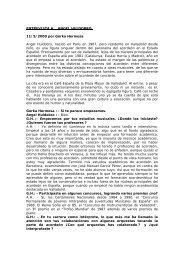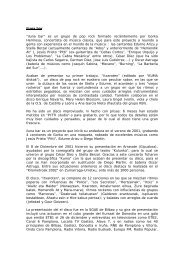The Accordion in the 19th Century - Gorka Hermosa
The Accordion in the 19th Century - Gorka Hermosa
The Accordion in the 19th Century - Gorka Hermosa
Create successful ePaper yourself
Turn your PDF publications into a flip-book with our unique Google optimized e-Paper software.
III.2- <strong>The</strong> diatonic accordion <strong>in</strong> <strong>the</strong> music of <strong>the</strong> 19 th century<br />
III.2.1- Spread of <strong>the</strong> diatonic accordion <strong>in</strong> <strong>the</strong> 19 th century<br />
Although soon after its <strong>in</strong>vention <strong>the</strong> accordion was <strong>in</strong>troduced <strong>in</strong> <strong>the</strong> wealthy<br />
social classes, before long, lower social classes took over <strong>the</strong> <strong>in</strong>strument, to become<br />
with <strong>the</strong> pass of time, an ostracized <strong>in</strong>strument generally played by street musicians all<br />
over <strong>the</strong> world. Its melancholic sound, its easy portability, its substantial loudness and<br />
musical possibilities -like <strong>the</strong> feasibility of play<strong>in</strong>g an accompanied melody- motivated<br />
people all over <strong>the</strong> world to play <strong>the</strong> accordion; this is shown by <strong>the</strong> early reference<br />
dates <strong>in</strong> which we have knowledge of <strong>the</strong> accordion: [40, 122, 142, 157, 202, 239, 244, 246, 253, 287,<br />
289, 310, 359, 415, 416]<br />
COUNTRY YEAR<br />
Austria 1829<br />
Russia 1830<br />
England 1831<br />
France 1831<br />
Germany 1834<br />
USA 1835<br />
Switzerland 1836<br />
Spa<strong>in</strong> 1836 144<br />
Scotland 1838<br />
Italy 183?<br />
New Zealand 1839<br />
Belgium 183?<br />
Iceland 1841<br />
Canada 1843<br />
Brazil 1845<br />
Japan 1850<br />
Argent<strong>in</strong>a 1852<br />
Ireland 1855<br />
Australia 1855<br />
Madagascar 1870<br />
34<br />
<strong>The</strong> most widely used accordion <strong>in</strong> <strong>the</strong> 19 th c. were <strong>the</strong><br />
diatonic ones, with a s<strong>in</strong>gle row of buttons on <strong>the</strong> right<br />
keyboard and two buttons on <strong>the</strong> left 145 , produc<strong>in</strong>g a bass and<br />
a chord (tonic or dom<strong>in</strong>ant depend<strong>in</strong>g on <strong>the</strong> bellows open<strong>in</strong>g<br />
or clos<strong>in</strong>g). <strong>The</strong> musical ambition of most accordionists did<br />
not go fur<strong>the</strong>r than just learn<strong>in</strong>g simple melodies. At <strong>the</strong> end<br />
of <strong>the</strong> 19 th c., <strong>the</strong> performers with more enthusiasm or<br />
resources started to use accordions with two rows on <strong>the</strong> right<br />
board, s<strong>in</strong>ce <strong>the</strong>y could ga<strong>in</strong> a wider range of altered notes.<br />
<strong>The</strong> <strong>in</strong>crease <strong>in</strong> <strong>the</strong> quantity of notes on <strong>the</strong> right board did not<br />
get much circulation and <strong>the</strong> 19 th c. unisonoric accordions did<br />
not become o<strong>the</strong>r than prototypes with very limited<br />
propagation. [96, 202, 211]<br />
With <strong>the</strong>se narrow resources, <strong>the</strong> repertoire that <strong>the</strong><br />
19 th c. accordionists played did not go beyond easy melodies<br />
from well known classical works to folk or popular rhythms,<br />
that is to say, tonal pieces with very few alterations and<br />
harmonic accompaniment exclusively tonic and dom<strong>in</strong>ant,<br />
generally learnt by ear. Only a few of <strong>the</strong>m dared to try<br />
compositions with more difficulty, but <strong>the</strong>y usually were only<br />
variations on <strong>the</strong> melodies or rhythms mentioned above. [96,<br />
202]<br />
Dur<strong>in</strong>g <strong>the</strong> 19 th c., learned music circles ignored <strong>the</strong> diatonic accordion almost<br />
completely. <strong>The</strong> concert<strong>in</strong>a, thanks to Giulio Regondi pr<strong>in</strong>cipally, had significant<br />
acceptance <strong>in</strong> England between 1840 and 1860 and for this, early romantic-style<br />
compositions, with ballroom music rem<strong>in</strong>iscences, were written. But <strong>the</strong> best accepted<br />
free reed <strong>in</strong>strument was certa<strong>in</strong>ly <strong>the</strong> harmonium, with a huge extremely <strong>in</strong>terest<strong>in</strong>g<br />
repertoire. [96]<br />
143 Fig. taken from: Dieterlen [66] page 1312.<br />
144 <strong>The</strong> newspaper Diario de Madrid published <strong>the</strong> follow<strong>in</strong>g advert on 2/7/1840: “A family leav<strong>in</strong>g our city has to sell varied<br />
furniture such as wardrobes, an office desk, a bedside table, a dress<strong>in</strong>g table, some blankets, a cot with a brand new mattress, a<br />
nearly new and complete French fireplace with match<strong>in</strong>g fireplace screen, a heater, etc., as well as a medic<strong>in</strong>e store box with set<br />
English scales, an ebony flute with eight silver keys, a beautiful portable map of Spa<strong>in</strong> and Portugal, new and pr<strong>in</strong>ted <strong>in</strong> London, a<br />
checkers set, a metal Dutch oven, an accordion, an overnight bag, a fea<strong>the</strong>r scarf, a fur neckerchief, a tablecloth set, and several<br />
books. All <strong>the</strong>se items will be on sale from today, 2 nd of <strong>the</strong> current month, at Calle Carretas, 13, 4 th floor door No. 3, opposite <strong>the</strong><br />
Post Office, from 9 a.m. to 1 p.m. and from 5 p.m. to 7 p.m. [310]<br />
145 Ma<strong>in</strong>ly due to <strong>the</strong> fact that <strong>the</strong>y were cheaper and it was easier to learn to play <strong>the</strong>m.




